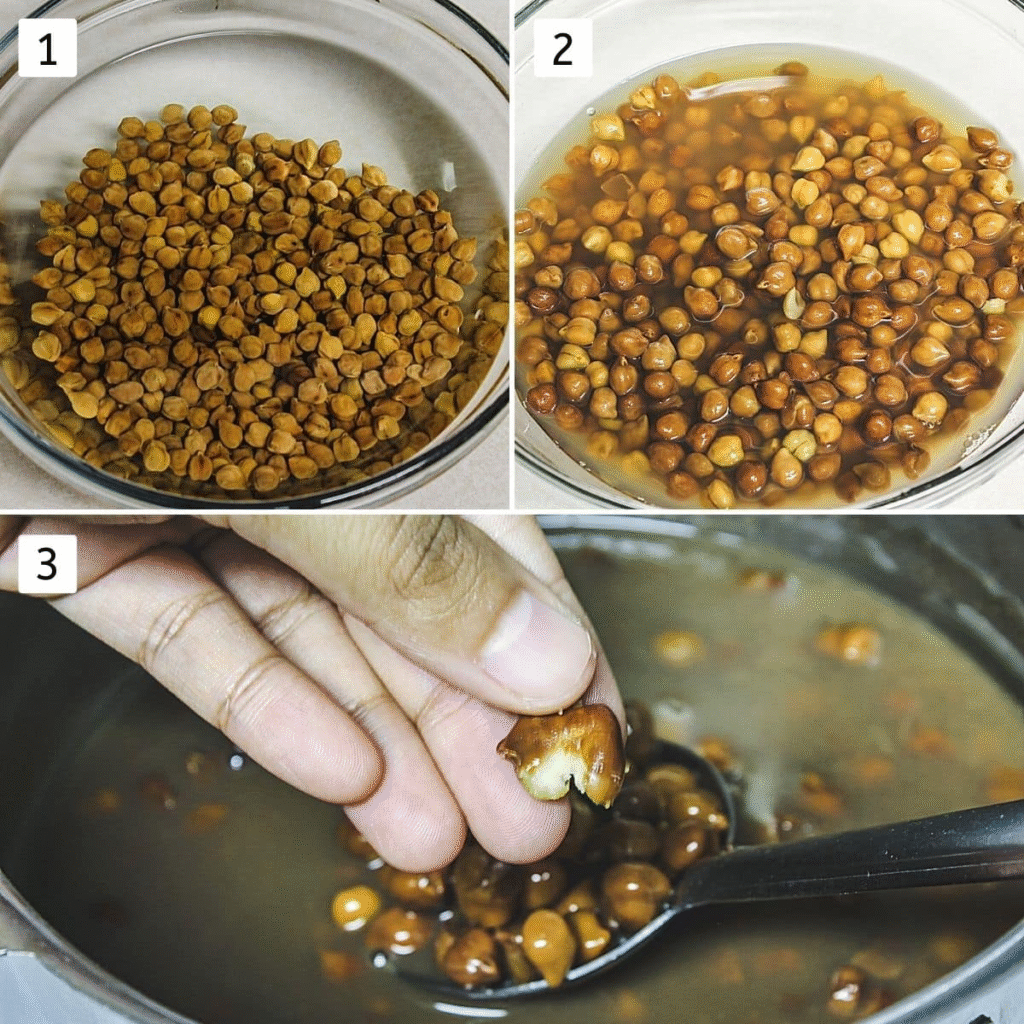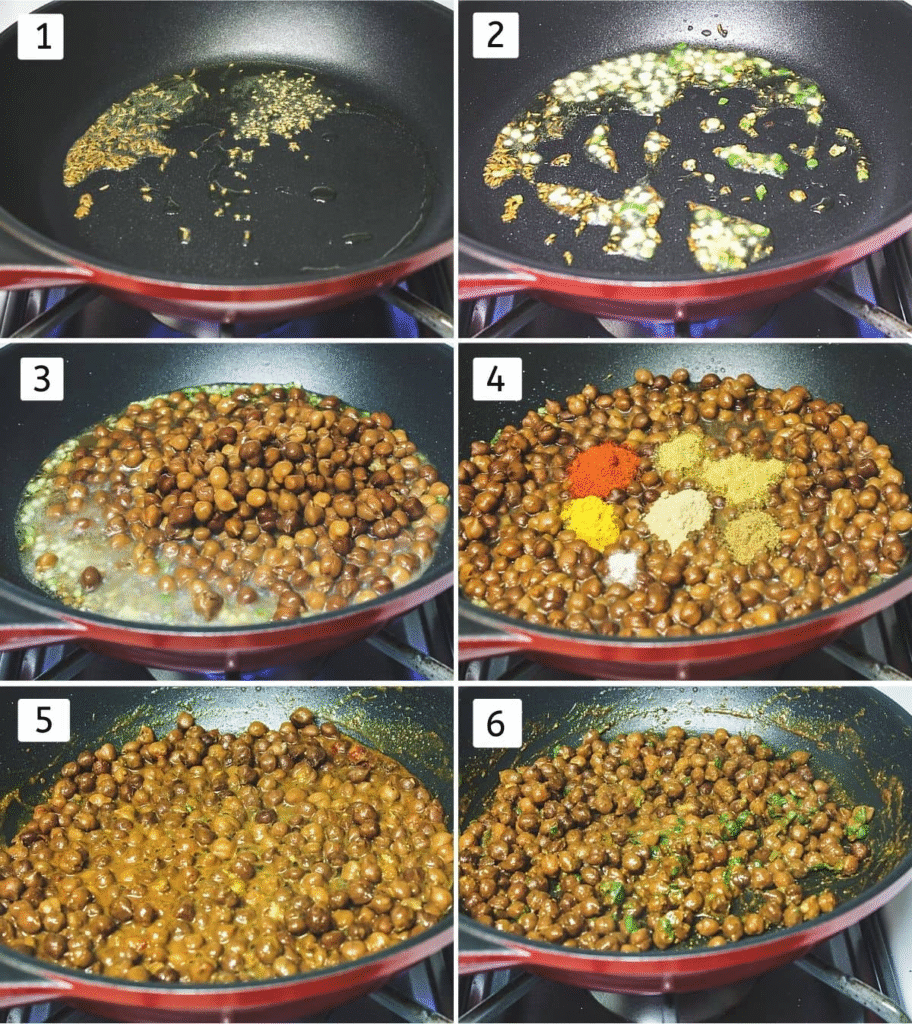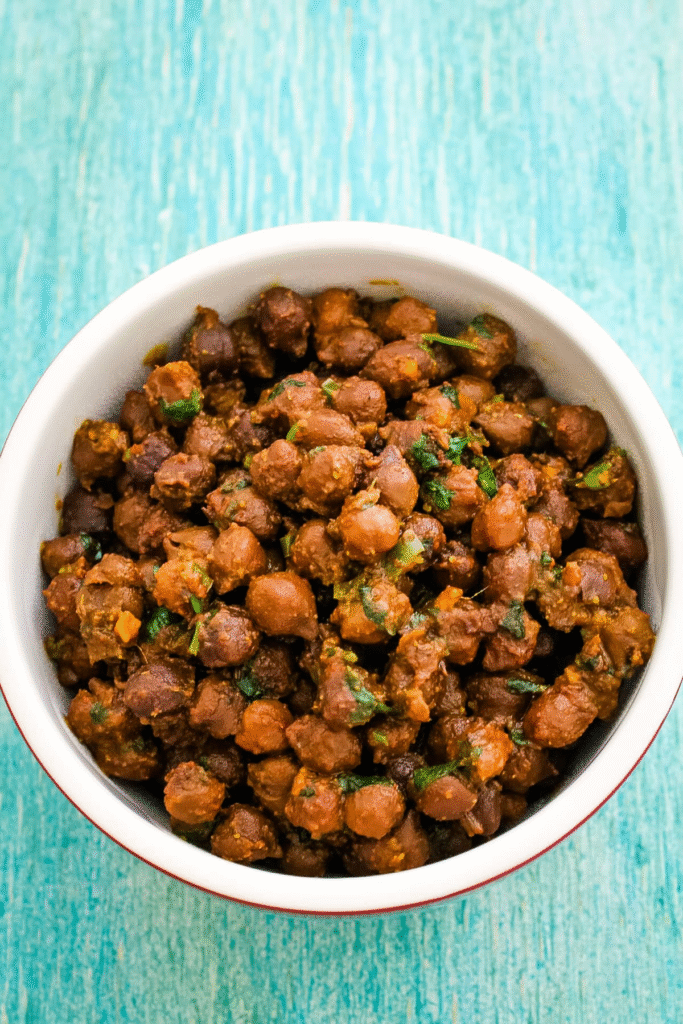This dry chana recipe is incredibly easy to prepare and packed with flavor, making it a perfect addition to any meal or even a wholesome snack on its own. It features black chickpeas (kala chana), which are cooked until tender and then sautéed with a medley of aromatic Indian spices that give the dish its distinctive taste. The use of minimal oil and basic pantry spices makes this dish both healthy and budget-friendly.
In Hindi, this dish is often referred to as Sukha Kala Chana or Sukhe Kale Chane. The word “sukha” or “sukhe” translates to “dry,” indicating that the chana is not prepared in a curry or gravy, but rather as a dry, spiced stir-fry. Despite its simplicity, the dish bursts with flavor—thanks to the well-balanced combination of cumin seeds, ginger, green chilies, garam masala, and a hint of amchur (dry mango powder) which adds a subtle tang.
Traditionally, this dish holds a special place during festivals like Navratri, where it is often served as a part of the ashtami prasad along with halwa and puri. But beyond festive occasions, it’s also enjoyed as a protein-rich side dish or a light, satisfying meal when paired with roti or paratha. This humble yet delightful preparation showcases how basic ingredients, when treated with care and the right blend of spices, can create something truly delicious.

❤️ About This Sukha Kala Chana Recipe
Taste & Texture:
- A rich depth of flavor comes primarily from the blend of fragrant, aromatic spices infused into the dish.
- These ground spices are gently simmered in the reserved water from the boiled chana, creating a rich and slightly thick masala. This richly spiced blend coats the soft, perfectly simmered chana, creating a mouthwatering and deeply satisfying culinary experience.
Quick & Easy Preparation: This dish can be prepared in just about 10 minutes if you already have boiled black chickpeas (kala chana) on hand. The actual cooking process is fast and hassle-free, making it ideal for busy mornings or quick weeknight dinners. However, it’s important to note that the chickpeas need to be soaked overnight and then pressure-cooked until soft, which requires a bit of advance planning. Fortunately, that soaking and boiling process doesn’t require constant supervision, and once that’s done, the rest comes together effortlessly in minutes. With a little preparation ahead of time, this recipe transforms into a quick and convenient option for a healthy, protein-rich meal.
When Is This Made?
- This Sukha Kala Chana holds a special place during the celebration of Ashtami—the final day of Navratri—when it is prepared as a sacred offering (prasad) for the Kanjak Pooja ritual. Traditionally, this dish is paired with fluffy, golden pooris and a decadent sooji halwa, enriched with aromatic ghee—also fondly called sheera in many Indian households.
- True to its devotional roots, this dry black chickpea dish is cooked without onion or garlic, in reverence to Devi Maa and the sanctity of prasad.
- While deeply rooted in tradition, I also enjoy making this dish regularly for simple, everyday meals. One of my absolute favorite comfort food combinations is this chana served with Gujarati kadhi and steamed rice. If you’ve never tried this trio—dry legumes with tangy yogurt-based curry and fluffy rice—you’re definitely missing out on an explosion of homestyle flavors.
- Not just limited to festive meals, this chana makes for a wholesome snack too. Serve it warm as a side salad, pack it in lunchboxes, or simply enjoy it by the handful as a protein-rich munchie!
🧾 Ingredient Notes

- Black Chickpeas (Desi Chana): This variety of chickpeas is smaller, darker, and more robust in flavor compared to regular white chickpeas. Commonly known as desi chana, it’s rich in protein and fiber, making it a hearty choice for traditional Indian dishes.
- Ginger & Ajwain (Carom Seeds): Since black chickpeas can be a bit dense and heavy on the stomach, I include fresh ginger and a pinch of ajwain to promote better digestion. You can also sprinkle a little hing (asafoetida) for added digestive support and a unique umami touch.
- Green Chilies: They bring a gentle kick of heat that elevates the overall flavor profile, adding a lively touch without overpowering the dish. You can increase, reduce, or completely omit them depending on your spice tolerance. If preparing this for young children, it’s best to leave them out.
- Ground Spices: The flavor foundation comes from everyday Indian pantry staples—turmeric, red chili powder, coriander powder, cumin powder, and a dash of garam masala. Together, they harmonize to deliver a well-rounded depth of flavor—rich, vibrant, and perfectly balanced with just the right touch of warmth and spice
- Amchur (Dry Mango Powder): This adds a gentle tang that brightens up the dish. If amchur is unavailable, a splash of fresh lemon or lime juice added at the end works beautifully as a tangy alternative, delivering that same zesty brightness to the dish.
👩🍳 How To Make Dry Chana? (Stepwise Photos)
Soaking & Cooking:
1)Rinse Thoroughly: Begin by washing the dry black chickpeas under cold running water until the water turns clear. Alternatively, rinse them 2-3 times in a bowl, changing the water each time, until no cloudiness remains.
2)Soak Overnight: Transfer the cleaned chickpeas to a large bowl and add enough water to cover them by 2–3 inches. Let them soak for a minimum of 8 hours or overnight for best results.
3)Drain and Prep for Cooking: They’re now ready to be pressure-cooked to soft, melt-in-mouth perfection. Transfer the soaked kala chana into a pressure cooker or Instant Pot, ready to be cooked until perfectly tender.. Add fresh water—enough to submerge them completely—and cook until they become tender. When done, the chickpeas should mash easily when pressed between your thumb and forefinger.
- Using a stovetop pressure cooker: Cook for 2 whistles on high flame, then reduce to medium-low and cook for another 30 minutes.
- In an Instant Pot: Set to Manual mode on high pressure for 30 minutes.

Making Dry Kala Chana Recipe:
1) Heat the Oil and Temper the Spices: Begin by heating oil in a heavy-bottomed pan or kadhai over medium heat. Once the oil is hot and shimmering, add cumin seeds and ajwain (carom seeds). Allow them to crackle and release their aromatic essence into the oil—this should take just a few seconds.
2) Sauté Aromatics: Immediately add freshly grated or finely chopped ginger along with slit or chopped green chilies. Sauté this mixture for 30 to 40 seconds, or until the raw smell of ginger fades away and it starts turning slightly golden. This step enhances the digestion-friendly quality of the dish and infuses it with warmth and mild heat.
3) Add Boiled Chana: Now add the previously boiled black chickpeas (kala chana) to the pan. Along with it, pour in about ½ cup of the reserved water from boiling the chana—just enough to help the spices coat the chana well. You can save the rest of the water for kneading dough or adding to dals or gravies for extra flavor and nutrition.
4) Spice It Up: Sprinkle in all the spice powders at this stage—red chili powder for heat, roasted cumin powder and coriander powder for earthiness, amchur powder for tanginess, garam masala for warmth, and black salt for an umami kick. Also, add regular salt to taste. Mix everything thoroughly so that the spices distribute evenly over the chana and the water begins to absorb their essence.
5) Simmer to Perfection: Let the mixture simmer uncovered on medium heat. Stir occasionally as the chana absorbs the flavors and the excess moisture begins to reduce. Continue cooking until the liquid has nearly evaporated and you’re left with a thick, spicy coating clinging to each chickpea. This might take around 6–8 minutes, depending on the heat and moisture level.
6) Finish and Garnish: Once the chana is dry and flavorful, switch off the heat. Sprinkle a generous handful of freshly chopped coriander leaves (cilantro) for a fresh burst of color and aroma. Give it a final mix. Your dry kala chana is now ready to be served.

💭 Expert Tips
- Toss the Soaking Water: Once the black chickpeas (kala chana) have soaked for several hours or overnight, be sure to get rid of the soaking liquid. . This step is crucial because the soaking water contains compounds released from the legumes that can cause bloating or indigestion. For the actual cooking process, always use fresh, clean water. This not only improves the flavor but also aids better digestion.
- Adjust spice levels for younger children: When preparing this dish as part of the Ashtami prasad or for small children, especially the little girls (kanjaks) being served during the Kanjak Pooja, it’s important to consider their spice tolerance. If you’re making the recipe for young ones who might not be comfortable with heat, reduce or completely omit green chilies and cut down on the red chili powder. The dish will still be flavorful, thanks to the combination of other aromatic spices, without being too spicy for delicate taste buds.
- Don’t waste the leftover chana water – it’s liquid gold: This recipe only requires about ½ cup of the water in which the black chickpeas were boiled. You will likely be left with a significant amount of this nutritious liquid. This chana water is packed with flavor and nutrients, making it perfect for kneading dough for roti or paratha. It adds a subtle earthy taste and boosts the nutritional value of your bread. Alternatively, you can use it as a base for dals, curries, or other gravy-based dishes for added depth and richness.

